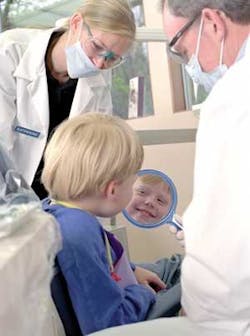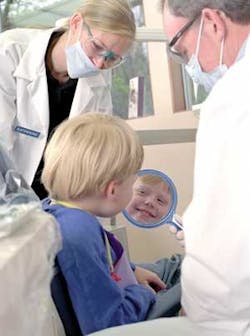PRODUCTION INCREASE
Many dentists spend up to 40 percent of their time in managerial and operational activities that they think save money when, in fact, those activities decrease the time they can focus on direct patient care. These do-it-yourself attempts to save money often compromise the potential for practice growth.
Driving practice growth
Sixty-six percent of dental practices are owned by individual doctors, according to a 2002 American Dental Association survey. While these practice owners can be highly skilled practitioners, they often have limited business education or experience and spend significant time on the management and operations of their practices. The reasons for this include:
• Doctors retain responsibilities that were more applicable when their practices were smaller.
• Certain tasks were never delegated as practices grew.
• Many dentists think they are more adept than their dental teams in handling management responsibilities.
• Dentists often feel obligated to control managerial and operational issues, even if they do not have the time to handle these functions.
Effective use of doctor time
While the industry model for dentistry is to provide the highest quality patient care in a customer-oriented environment, this model needs to be combined with an understanding of production and profit targets. This approach is necessary if a doctor wishes to provide excellent care to patients. Why? Those profit targets provide funding to invest in the best team, continuing education, supplies, and equipment - all of which add to superior patient care. Of course, to sustain production and profit, a doctor must be chair-side.
The most effective use of doctor time is direct patient care, which most dentists prefer. In a recent Levin Group study, more than 95 percent of dentists reported they do not enjoy the managerial and operational aspects of running a practice. While they are happy when they are involved in direct patient care, dentists typically feel a strong responsibility to manage some or all of the following functions, as well:
• Accounting
• Banking
• Dealing with attorneys
• Human resources
• Benefits analysis
• Team building
• Supply and equipment selection
• Inventory control
• Inventory ordering
• Supply-rep relationships
• Customer service
How can doctors begin to shift the amount of time they spend on these operational issues to direct patient care? Although most dentists report that they would not be interested in working more hours, they spend significant hours managing their practices. If a small amount of that managerial time were rededicated to direct patient care during operational hours, practice production and profitability would invariably expand.
In-sourcing to the team
Any shift by a dentist to higher percentages of direct patient care away from managerial and operational issues will increase practice production. Doctors need to look at their average hourly gross production rates and think about how much time they spend on managerial and operational responsibilities. These tasks must be delegated to others. A dentist’s time is too valuable to spend anywhere but chair-side. How do you make the shift?
First, evaluate opportunities to delegate as many managerial and operational tasks as possible. How many activities performed by dentists can be delegated or in-sourced to staff with a high level of trust? For example, identify a team member who will become responsible for hiring. This person can be trained easily in a two- or three-day course on human resource issues. Then, the practice can spend a small amount of money on a labor law attorney who will outline specific hiring steps that must be followed and provide practice-related information to guide a trusted team member.
In-sourcing can also include the creation of step-by-step checklists that are followed by staff and handed to doctors daily, weekly, and monthly.
At least 10 to 20 functions can be handled effectively by teams. These include opening and closing the office, accounts receivable reconciliation, daily balances, reports of financial controls, collection numbers, collection activities, overdue patient reports, and reduction of overdue patients. All are key performance indicators, or KPIs, that can be handled and completed by dental teams. KPIs then can be reported to doctors for review. Some areas get no attention by dentists or teams, while others use precious doctor time.
Other in-sourcing opportunities include increasing the responsibilities of the office manager, who should handle or delegate most of the daily administrative tasks for the practice. Office managers must play roles in daily practice operations as well as strategic planning. They also can spearhead special projects for doctors such as implementing new technologies into practices.
Office managers can evaluate supplies and equipment. Many dentists still do their own ordering because they think it is most cost effective - a normal belief among small-business owners. Nevertheless, many do not factor in the value of their time in dealing with supplies and equipment.
A new client complained recently that he had to sit in the office four to five hours while a repair specialist worked on a new piece of equipment. It never occurred to the dentist to delegate interaction with the repair representative while he stayed chair-side.
Many team members can handle basic supply ordering, which could be monitored by practice accountants or office managers to make sure orders are within percentages of revenue allocated to supplies.
Using their knowledge of doctors’ product preferences, team members can work with supply representatives and list the benefits of types of equipment and provide final sets of options to dentists. By following this procedure, doctors are only involved in brief, final meetings with team members and their supply representatives. Well-trained team members can handle basic negotiations if dentists finalize at the end. This is a better, less confrontational strategy than when dentists negotiate directly because it creates room for team members to negotiate in advance.
Out-sourcing to others
While many aspects of office management can be delegated to dental teams, some areas require expertise found outside practices. Using a payroll service, which has become popular with some practices, reduces the time doctors need to spend on payroll-related activities. In addition, payroll services often keep better records. There are many other out-sourcing opportunities. Advisors, consultants, accountants, and attorneys can help businesses with some portion of their operations and compensate for most practices’ lack of highly trained business staff members. Once again, this either will allow dentists to spend more time in direct, patient-related activities or have more free time, which will reduce stress and improve the quality of dentists’ lives.
Delegating to increase production
How much time do dentists spend in direct-patient production? Spend a day with a stopwatch and only allocate stopwatch time when involved in direct patient care. Our time studies show that most dentists spend only 60 percent to 70 percent of their time each day involved in direct patient care. They spend the remainder in communication, managerial activities, and decision-making. In fact, when 30 percent or 40 percent of doctor time is spent on activities other than direct patient care, practices automatically underperform. It is easy to be deceived into thinking production is high when you work hard handling managerial and operational issues. Unless you spend 80 percent or 90 percent of your time in direct patient care, you are probably missing opportunities for increased production. Of course, the effect is cumulative. A consistent lack of production during a 20- or 30-year career will ultimately delay retirement. In fact, many dentists are unable to comfortably retire by age 60. According to Michael Smith, vice president of Levin Financial Services Inc., many think they earn enough but find they have not saved enough.
Many practices experience a $6 million to $9 million loss in production during 20 years because of how practices are operated and how dentists spend their time.
Of 640 practices that enrolled in Levin Group programs last year, more than 80 percent reported they felt somewhat out of control, overwhelmed, and stressed. Given that stress is a clear benchmark of inefficiency, systems can enhance practice production, but equally important is the use of doctor time relative to direct patient care.
Evaluate practice production goals. The goal of any practice should be to hit production and profit targets to properly provide the best care and customer service. Quality should be considered in any health care profession, but production and profit are also driving factors. Many dentists spend up to 40 percent of their time on non-revenue production activities. If a practice simply shifts 20 percent of its time to direct patient care (without adding any hours), it can grow significantly. Evaluating use of doctor time can impact the financial success of a practice.
Roger P. Levin, DDS, MBA, is founder and CEO of Levin Group, Inc., a leading dental-management consulting firm specializing in implementing documented business systems into dental practices. Levin Group can be reached at (888) 973-0000 or at www.levingroup.com.

